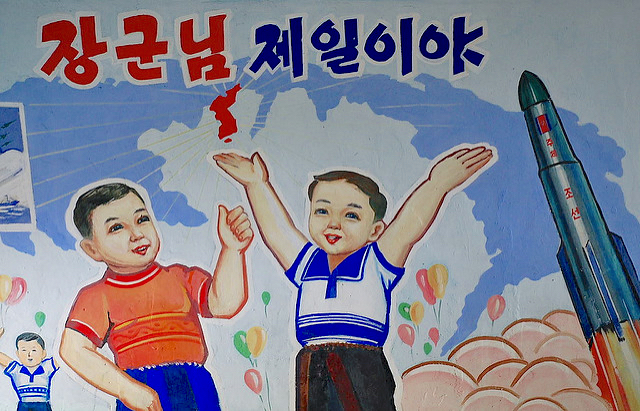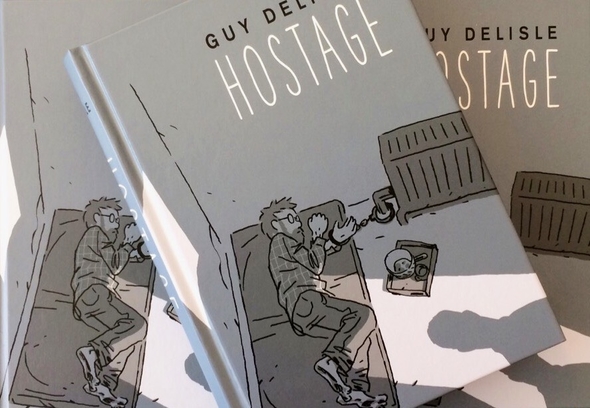“Kitsch is the absolute denial of shit,” Milan Kundera famously snarled in his 1984 novel, The Unbearable Lightness of Being. In his story, a painter declares an aesthetic war on the kitschy pop culture that was crafted and enforced by communist Czech bureaucrats during the Prague Spring revolt of 1968. And what was particularly diabolical about tacky fluff? “Kitsch causes two tears to follow in quick succession. The first tear says: ‘How nice to see children running on the grass!’ The second tear says: ‘How nice to be moved, together with all mankind, by children running on the grass!…The brotherhood of man on earth will be possible only on a basis of kitsch.”
Of course, kitsch as defined by Kundera is forced by gunpoint in a totalitarian society to ensure that its slave-citizens believe they live in the best and happiest place on Earth. Such an ethos has dominated North Korean pop culture under the rule of an aesthete who had a zest for bouffant hairdos, polyester suits, platform shoes, and had a habit of inspecting banal products at supermarkets such as toilet paper, sausages, and plastic bowls as if they were fine pieces of art.
It can be difficult to not snicker at the pop culture of Supreme Leader Kim Jung-il’s fantasy kingdom that he recently departed. We have the religious origin of his birth at the sacred Mount Paektu where a double rainbow appeared and a talking iceberg foretold of his arrival (or according to North Korean government officials). North Korean television is full of grandiose Busby Berkeley-esque musicals of goose-stepping women in military drab and full army choirs who sing praises of the Supreme Leader to a vaguely funky beat. Kim Jong-il famously had South Korean filmmaker Shin Sang-ok kidnapped and forced to direct Pulgasari, a Godzilla knockoff. There’s a poignant scene in the 2003 graphic novel, Pyongyang – A Journey In North Korea where Canadian author and animator Guy Delisle watches a concert by gifted students at a North Korean school. He watches 8-year-old children dexterously play accordions while straining and sweating to keep “Miss World” smiles. “As though the thin veneer of their smiles were proof that these young prodigies are flourishing here, it’s all so cold…and sad,” Delisle reflected. “I could cry.”
Many jaundiced Western eyes like mine glared at North Korean kitsch right after Kim Jung-il died. There was validation for the old suspicion that kitsch is a narcotic used by state powers to distract the masses from knowing the horrible conditions they truly live in. The distractions worked: North Korea suffered the loss of two million civilians to starvation and disease during the 1990s famine. I was particularly startled by the number of North Korean cartoons on YouTube, where anthromorphized potatoes and frogs brutally defended crops from foreign invaders, as if to teach children that Kim Jong-il’s regime was always on their side even if most of the food rations went to the military and government workers. And then there is the government policy of embedding spies in every neighborhood who can bring about the arrests of three generations worth of a suspected dissident’s relatives. Those atrocities abounded in Western media stories, when images of North Koreans hysterically crying over Kim Jong-il’s death were circulated. Many outsiders wondered how so many people could grieve over a dictator who deeply savaged their lives. Others wondered what would become of Jong-il’s young, inexperienced successor Kim Jung-un who many cynical Westerns mocked for having a portly Teddy Bear physique while millions of his countrymen starved.
Commie Funky Town?
My attention recently went to an oddball CD of North Korean pop songs that amused many American critics seven years ago. The 2005 compilation, Radio Pyongyang: Commie Funk and Agit Pop from the Hermit Kingdom, is a mix of music recorded via television and shortwave radio by Christiaan Virant, an American musician based in China who is best known for creating Buddha Machine music boxes in the ambient group FM3. Sublime Frequencies, a Seattle record label co-owned by the Sun City Girls’ Alan Bishop, caught many curious and jaded ears with the release as well as the Cambodian Cassette Archives, a collection of pre-communist Cambodian pop songs. While the latter was respected as a trove of artifacts tragically lost during Pol Pot’s brutal reign, Radio was widely considered to be a tragicomedy from the Axis of Evil. Virant’s liner notes are soaked in snark. “Schmaltzy synthpop, revolutionary rock, cheeky child rap, and a healthy dose of hagiography for Dear Leader Kim Jong-il. That is the now sound of North Korean!” he wrote.
Many of Radio’s tracks are steeped in shameful camp to my ears that spent years being trained by punk and indie bands to disdain anything that reeked of “corporate pop.” At the forefront of the mix is Taejung Kayo, the most common pop genre that fuses military marching song, orchestral ballads, synthpop, opera, and light funk or “Commie Funk” as the compilation calls it. A female singer operatically sing praises of the Supreme Leader in a typical Taejung song that embodies the ethos of Kim Il-Sung’s Juche ideology of nationalist isolation from the outside world. Jong-il, ever the aesthete, formed the Wangjaeson Light Music Band in the early 80s to promote Taejung Kayo (a simple feat to accomplish since they were one of the rare North Korean groups to actually have records for sale to the few who could afford them). The Pochonbo Electronic Ensemble also pioneered the genre that oddly includes many 80s Western pop influences for music that’s supposedly isolated in the Hermit Kingdom.
Electric bass guitar lines and vaguely polka drum beats abound in Radio and wouldn’t be too out of place at a Country line-dancing club in Wyoming. The music is also saturated in cavity-inducing synthesizer melodies and hollered military marches that conjure up images of jackboots goosestepping at Disneyland’s Main Street Electrical Parade. In the track, “Get Them While They’re Young,” young singers cartoonishly yelp for a children’s dance piece. Amid a “megamix” of pop songs, a high-pitched tone interrupts from a government “numbers station” where a code is delivered to awaiting North Korean agents to carry out missions that are unknown to civilians. Virant reminds us what lurks in the shadows behind the Candy Land anthems.
There’s scene in Delisle’s Pyongyang where the Canadian visitor is stuck on a slow highway trip to his hotel from a museum where a large detachment of soldiers tearfully bowed to a life-sized statue of Eternal President Kim Il-Sung. He’s driven mad by a cassette loop of Taejung pop songs. “I manage to make out Bimbo Jet, Copacabana, and Santa Lucia all interpreted with a huge string session and two-bit synthesizers. It’s nauseatingly sweet,” he complains. The Canadian visitor’s attention then goes to his North Korean guides in the front seats. “While I drown in the “Beautiful World of Candy, Candy, I can tell that they’re cruising through a remake of Easy Rider.” A humorous image of the guides dressed as Dennis Hooper and Peter Fonda riding motorcycles on a North Korean highway then appears. The last image stuck with me since Delisle saw two men who listened to such “Candy, Candy” music all their lives and felt empowered by such camp in knowing they’re under the Supreme Leader’s graces.
It makes me wonder what would become of North Korean culture if its nation ever reunifies with South Korean under non-communist rule. How would they integrate into a world that mocked their culture for several decades and considered them to be mindless slaves? What would they think of the Western world they were raised to loathe? In Pyongyang, Delisle wonders about the absence of disabled citizens on the streets of the capital city. His guide assures them they don’t exist in a nation where all citizens are “born strong, intelligent, and healthy.” Delisle then ponders, “To what extent can a mind be manipulated? We’ll probably get some idea when the country eventually opens up or collapses.”
Photograph courtesy of Charlie Wollborg. Published under a Creative Commons license.






“How would they integrate into a world that mocked their culture for several decades and considered them to be mindless slaves?”
What society is not mindless slaves? We all know who our masters are. We are all slaves. Easy to mock those poor yellow North Koreans. Look at the slave in the mirror.